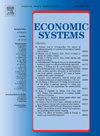FDI生产率溢出的时空动态:技术差距视角
IF 3.3
2区 经济学
Q1 ECONOMICS
引用次数: 0
摘要
新兴文献对外商直接投资(FDI)的生产率溢出进行了估算,但对时空动态和技术差距对FDI生产率溢出的影响研究不足。为了为国际政策分析提供更全面的估计,本研究利用53个“一带一路”倡议国家2003-2020年的样本对其影响进行了估计,并捕捉了技术差距条件下FDI生产率溢出的时空动态。此外,本文还研究了FDI对生产率溢出的影响渠道。研究表明,中国对外直接投资(OFDI)引发的溢出效应通过促进产业和劳动力结构的转变,以及优化资本配置,对东道国的生产率增长做出了重大贡献。然而,溢出效应随着技术差距的扩大而减弱,特别是在超过一定阈值时。时间分析表明,随着时间的推移,生产率溢出有增强的趋势。空间分析表明,中国对外直接投资呈现负的空间溢出效应,表明在吸引外资方面存在竞争动态。本文章由计算机程序翻译,如有差异,请以英文原文为准。
The temporal and spatial dynamics of FDI productivity spillovers: A technology gap perspective
An emerging literature estimates the productivity spillovers of foreign direct investment (FDI), but the temporal and spatial dynamics and the impact of the technology gap on FDI productivity spillover are insufficiently investigated. To provide a more comprehensive estimate for the international policy analysis, the study estimates the effects by utilizing the sample of 53 "Belt and Road" Initiative countries over the period 2003–2020 and captures the temporal and spatial dynamics of FDI productivity spillovers conditional on the technology gap. Moreover, the channels of FDI spillovers on productivity are investigated. The study reveals significant contributions of Chinese outward foreign direct investment (OFDI) -induced spillovers to the host countries' productivity growth by facilitating transformations in industrial and labour structures, alongside optimizing capital allocation. Nonetheless, spillover effects diminish with widening technology gaps, especially when exceeding a certain threshold. Temporal analysis indicates a strengthening trend in productivity spillovers over time. The spatial analysis demonstrates that Chinese OFDI exhibits negative spatial spillover effects, indicating the presence of competitive dynamics in attracting foreign capital.
求助全文
通过发布文献求助,成功后即可免费获取论文全文。
去求助
来源期刊

Economic Systems
ECONOMICS-
CiteScore
4.90
自引率
0.00%
发文量
83
审稿时长
48 days
期刊介绍:
Economic Systems is a refereed journal for the analysis of causes and consequences of the significant institutional variety prevailing among developed, developing, and emerging economies, as well as attempts at and proposals for their reform. The journal is open to micro and macro contributions, theoretical as well as empirical, the latter to analyze related topics against the background of country or region-specific experiences. In this respect, Economic Systems retains its long standing interest in the emerging economies of Central and Eastern Europe and other former transition economies, but also encourages contributions that cover any part of the world, including Asia, Latin America, the Middle East, or Africa.
 求助内容:
求助内容: 应助结果提醒方式:
应助结果提醒方式:


